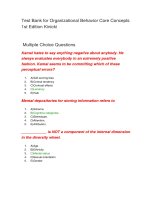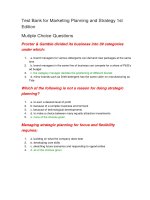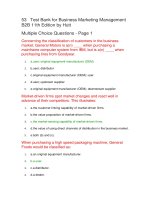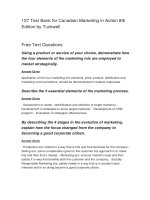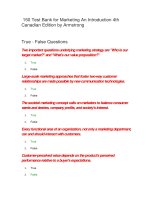Test bank for family focused nursing care 1st edition by denham
Bạn đang xem bản rút gọn của tài liệu. Xem và tải ngay bản đầy đủ của tài liệu tại đây (276.09 KB, 9 trang )
Test Bank for Family Focused Nursing Care 1st Edition
by Denham
Link full download: />
Chapter 6- Cultural and Diversity Aspects of Health and Illness Care Needs
MULTIPLE CHOICE
1.Which of the following is the most important reason for offering culturally sensitive care?
1.
To make patients feel comfortable
2.
To offer safe care
3.
It is required by law
4.
It increases patient satisfaction
ANS: 2
Feedback
1 Even though making a patient feel comfortable is important, safety is of higher priority
2 Patient safety is a cornerstone of nursing practice.
3 While some aspects of cultural sensitivity, i.e., provision of interpreters for individuals who are deaf, may be required, most e
4 Even though patient satisfaction is important, safety is of higher priority.
PTS:1
KEY: Content Area: Introduction to culture | Integrated Process: Caring | Client Need: Safe and Effective Care
Environment | Cognitive Level: Evaluation | Question Type: Multiple Choice
2.According to Taylor, which of the following is not considered to be one of the three levels of culture?
1.
Cultural tradition
2.
Subculture with shared traits in a different society
3.
Cultural universals
4.
Socioeconomics
ANS: 4
Rationale:
Cultural tradition, subculture with shared traits in a different society, and cultural universals are all considered by
Taylor to represent levels of culture. Socioeconomics is important but not considered by Taylor to be part of the
levels of culture.
PTS:1
KEY: Content Area: Introduction to culture (Box 6.01) | Integrated Process: Caring | Client Need: Safe and Effective
Care Environment | Cognitive Level: Comprehension | Question Type: Multiple Choice
3.Which of the following factors would be the least likely to represent a cultural factor?
1.
Gender identity
2.
Family of origin
3.
Religion
4.
IQ
ANS: 4
Rationale:
While IQ measurement can be influenced by culture, gender identity, family of origin, and religion all represent
stronger cultural factors.
PTS:1
KEY: Content Area: Identifying culture (define culture) | Integrated Process: Caring | Client Need: Safe and Effective
Care Environment | Cognitive Level: Evaluation | Question Type: Multiple Choice
4.Which of the following statements would NOT be considered a characteristic of personal bias or stereotype?
1.
Ideas that are oversimplified in regards to a specific group
2.
Views that one group holds about another group
3.
Bias can be a useful starting point to offering culturally sensitive care
4.
Bias is hard to identify in one’s self
ANS: 3
Feedback
1
Ideas that are oversimplified in regards to a specific group is a characteristic of bias or stereotype.
2
Views that one group holds about another group is a component of bias or stereotype.
3
Bias is an ineffective starting point to offering culturally sensitive care because it does not allow for open communication.
4
Often, individuals are not aware of biases or stereotypes, and such beliefs can be difficult to identify.
PTS:1
KEY: Content Area: Bias and stereotype (stereotypical images) | Integrated Process: Caring | Client Need: Safe and
Effective Care Environment | Cognitive Level: Evaluation | Question Type: Multiple Choice
5.Which of the following is an example of ethnocentric thinking?
1.
Freedom is an important factor for individual development.
2.
Human interactions are complex.
3.
There is more than one way to look at a problem.
4.
No two families are the same.
ANS: 1
Feedback
1 In ethnocentric thinking, one sees her/his own worldview or values as applicable to everyone else. The concept of freedom is
2 Understanding that complexity is part of human interactions minimizes the likelihood of ethnocentric thinking.
3 In ethnocentric thinking, people only consider one way of looking at a problem.
4 In ethnocentric thinking, people often generalize their own experience to others and assume that all families are the same.
PTS:1
KEY: Content Area: Ethnocentrism (cultural ambiguity) | Integrated Process: Caring | Client Need: Safe and
Effective Care Environment | Cognitive Level: Comprehension | Question Type: Multiple Choice
6.Which of the following changes in population demographics need to be taken into consideration in providing
culturally sensitive nursing care for families?
1.
Increase in migration patterns of different ethnicities
2.
Increasing recognition of GLBT families
3.
Increase in single parent families
4.
All of the above
ANS: 4
Rationale:
All demographic shifts should be considered when providing culturally sensitive nursing care for families, including
migration patterns and changes in family structure.
PTS:1
KEY: Content Area: Demographic changes (family households) | Integrated Process: Caring | Client Need: Safe and
Effective Care Environment | Cognitive Level: Comprehension | Question Type: Multiple Choice
7.Which of the following factors is likely to impact nursing care related to aging populations?
1.
There is a surplus of available nursing homes.
2.
More people will find themselves as the “sandwich generation,” caring for parents and children at the same time.
3.
Most elderly people are sick, frail, and dependent on others.
4.
All of the above.
ANS: 2
Feedback
1 There is not a surplus of available nursing homes. Many homes have waiting lists for admission. The lack of available spaces
2 Nursing care for aging populations will be affected by the growing “sandwich generation” of people caring for parents and ch
3 While elderly people may be sick, frail, and dependent on others, this is not a characteristic of most elderly people.
There is not a surplus of available nursing homes and many elderly people live independently and are not sick, frail, and de
affected by the growing “sandwich generation” of people caring for parents a
4
PTS:1
KEY: Content Area: Aging (using cultural models) | Integrated Process: Caring | Client Need: Safe and Effective
Care Environment | Cognitive Level: Evaluation | Question Type: Multiple Choice
8.Which of the following theoretical models would best help explain why a family might bring in their own “hot”
and “cold” foods for healing after a birth?
1.
The Family Health Model
2.
The Sunrise Model
3.
The Health Promotion Model
4.
The Health Beliefs Model
ANS: 2
Feedback
1 The focus of the Family Health Model is more on the role of family than the health needs of the individual. This answer is not
2 The Sunrise Model helps nurses understand the importance of understanding and respecting patients’ cultural health beliefs.
3 The Health Promotion Model focuses on how individuals can achieve changes that promote health; the focus is less on cultura
The Health Beliefs Model focuses on beliefs that people have regarding their health and how they can make changes. This
diabetes).
4
PTS:1
KEY: Content Area: Theoretical models (using models to understand culture) | Integrated Process: Nursing Process |
Client Need: Health Promotion and Maintenance | Cognitive Level: Application | Question Type: Multiple Choice
9.Which of the following areas of cultural behaviors would a nurse be assessing if using the transcultural nursing
assessment tool?
1.
Communication, social organization, biological variation, and socioeconomic factors
2.
Communication, time, biological variation, and socioeconomic factors
3.
Space, time, biological variation, and socioeconomic factors
4.
Communication, social organization, time, and biological variation
ANS: 4
Rationale:
Communication, social organization, time, and biological variation are elements of the transcultural assessment tool.
PTS:1
KEY:Content Area: Nursing assessment tools (Box 6.08 Culturally distinct behaviors) | Integrated Process: Nursing
Process | Client Need: Safe and Effective Care Environment | Cognitive Level: Comprehension | Question Type:
Multiple Choice
10.Which of the following is an example of cultural humility?
1.
A nurse familiarizes herself with the requirements of kosher food.
2.
A nurse believes that giving Jell-O to all patients after surgery has no cultural implications.
3.
Patients and family members are discouraged from praying on the floor to protect their hygiene and safety.
4.
ll of the above.
ANS: 1
Feedback
1 Understanding a patient’s cultural nutritional requirements is an example of cultural humility.
2 Jell-O contains animal products/pork and is not eaten by certain cultures.
3 Religious practices may have great significance and importance for patients. If the nurse believes these are problematic, soluti
4 Understanding a patient’s cultural nutritional requirements is an example of cultural humility. The other answers support the n
PTS:1
KEY: Content Area: Cultural humility | Integrated Process: Caring | Client Need: Safe and Effective Care
Environment | Cognitive Level: Application | Question Type: Multiple Choice
11.Which area is typically not included in the Assessment of Culturally Distinct Behavior (according to Giger and
Davidhizer)?
1.
Communication
2.
Social organization
3.
Time
4.
Developmental stage
ANS: 4
Rationale:
Communication, social organization, and time are a part of the Assessment of Culturally Distinct Behavior
(according to Giger and Davidhizer). Developmental stage is not a part of the cultural assessment, although it should
be taken into consideration.
PTS:1
KEY:Content Area: Assessment of culturally distinctive behavior (cultural models) | Integrated Process: Nursing
Process | Client Need: Safe and Effective Care Environment | Cognitive Level: Comprehension | Question Type:
Multiple Choice
12.Which of the following is the most important reason for knowing “family stories”?
1.
It is essential in relationship building.
2.
It helps the nurse predict future care needs.
3.
It is considered a best practice in customer service.
4.
None of the above.
ANS: 2
Feedback
1 Although hearing a patient’s story can help establish a relationship , the most important reason for assessing them is to get ins
2 Family stories relate past experiences that can help predict future needs.
3 Although hearing a patient’s story can help increase patient satisfaction , the most important reason for assessing them is to ge
4 Although hearing a patient’s story can help increase patient satisfaction and establish a relationship, the most important reaso
PTS:1
KEY: Content Area: Family story telling (the power of family stories for learning about cultural needs) | Integrated
Process: Caring | Client Need: Safe and Effective Care Environment | Cognitive Level: Evaluation | Question Type:
Multiple Choice
13.Which of the following resources is the most important source of cultural information to understand the culture of
a patient and family?
1.
CIA World Factbook
2.
Multicultural Resources for Health Information
3.
Office of Minority Health: Cultural Appropriate Services
4.
None of the above
ANS: 4
Rationale:
The family and patient are the most important source or information. Sources of information, such as websites and
books, can support understanding but should not be used as primary source.
PTS:1
KEY: Content Area: Cultural resources (use of cultural resources) | Integrated Process: Nursing Process | Client
Need: Safe and Effective Care Environment | Cognitive Level: Comprehension | Question Type: Multiple Choice
MULTIPLE RESPONSE
1.Which of the following are assumptions of the Health Belief Model?
1.
Individuals interact with the environment, transforming it and being transformed in the process.
2.
Health professionals must initiate the changes in order for change to occur.
3.
Individuals actively seek to regulate personal behaviors.
4.
Healthcare professionals are part of the interpersonal environment that influences people across their lifespan.
ANS: 1, 3, 4
Rationale:
The key person for making change is the patient.
PTS:1
KEY:Content Area: Health Belief Model (cultural models) | Integrated Process: Nursing Process | Client Need: Safe
and Effective Care Environment | Cognitive Level: Comprehension | Question Type: Multiple Response
2.Which of the following are reasons to involve an interpreter when working with a patient who speaks a different
language than the nurse?
1.
It is required by law.
2.
In order to make an accurate assessment.
3.
In order to develop a trusting relationship.
4.
An interpreter is likely to provide the intent of the discussion.
ANS: 2, 4
Rationale: Not having all the assessment data can lead to misdiagnosing a patient and thus puts the patient at risk.
Family members can provide observations of behavior and information about physical, emotional, and mental status
of individual members.
PTS:1
KEY: Content Area: Use of interpreters (using translators and interpreters with families) | Integrated Process: Caring
| Client Need: Safe and Effective Care Environment | Cognitive Level: Evaluation | Question Type: Multiple
Response
COMPLETION
1.Ideas about cultural sensitivity and cultural competence assert that the only culture that can truly be known is
____________________, and that the starting point of understanding is in ____________________.
ANS:
one’s own, self-knowledge
Rationale: One of the best ways to become culturally competent is to identify one’s own biases, assumptions, and
prejudices, and to identify goals for oneself with the aim of neutrality.
PTS:1
KEY: Content Area: Assessing culture (through a family lens) | Integrated Process: Nursing Process | Client Need:
Safe and Effective Care Environment | Cognitive Level: Comprehension | Question Type: Completion

